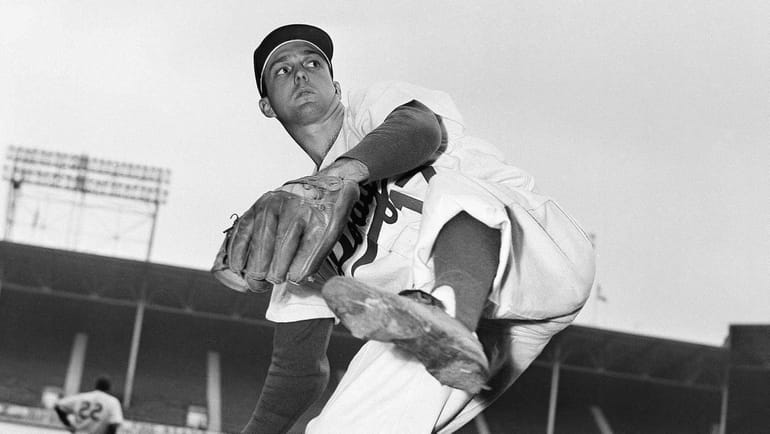Carl Erskine, former Brooklyn Dodger and last surviving member of 'Boys of Summer', dies at 97

Carl Erskine of the Brooklyn Dodgers in action on May 18, 1952. Credit: AP
Carl Erskine spent most of his life in his native Indiana, but that is a geographical footnote.
The guy was an honorary Brooklynite troo an’ troo, from his nickname, “Oisk,” to having a street there named in his honor.
That was Erskine’s reward for long and meritorious service to the borough as a mainstay of the Dodgers’ final decade in Brooklyn — and for helping keep watch over its legacy for decades beyond his playing days.
When he died Tuesday at age 97, it marked the end of an era that had been fading for years in living memory but will live on in baseball lore.
Erskine was the last surviving figure from Roger Kahn’s iconic 1972 book, “The Boys of Summer,” which revisits the Dodgers of the 1950s and helped romanticize that team and its time.
The man was born on Dec. 13, 1926, when Ty Cobb still was an active player and television had not yet been invented, and he lived to see the pitch clock and live-streamed baseball games.
And he could pitch! He spent his entire career with the Dodgers, from 1948 through ’59 — the last two of those seasons in Los Angeles — and went 122-78 with 981 strikeouts and a 4.00 ERA. He pitched in five World Series, only one of which the Dodgers won.
He threw two no-hitters, won 20 games in 1953 and struck out 14 Yankees in Game 3 of the ‘53 World Series.
He began his career primarily as a reliever but later became a starter. In that stellar ’53 season, he went 20-6 with career highs in strikeouts (187) and complete games (16).
One of Erskine’s most famous moments as a Dodger involved a game he did not appear in.
He was warming up alongside Ralph Branca in the ninth inning of Game 3 of the 1951 National League playoff against the Giants when the Dodgers called upon Branca to relieve Don Newcombe, believing his stuff looked sharper.
Bobby Thomson then famously beat Branca and the Dodgers with a three-run home run to win the pennant, giving Erskine a laugh line for the rest of his life.
Asked to name his best pitch, he would say, "The curveball I bounced in the Polo Grounds bullpen in 1951.”
After he retired as a player, Erskine returned to Indiana, where he worked as a television analyst and college coach.
He also was active in community and business organizations, serving as a bank president.
He had a particular interest in the Special Olympics, owing to his fourth child, Jimmy, who was born in 1960 with Down syndrome.
In 2023, he was named the winner of the Buck O’Neil Lifetime Achievement Award by the National Baseball Hall of Fame. It is given to people who have made extraordinary efforts to improve baseball’s impact on society.
“I’m a little overwhelmed, and this is very special to me,” Erskine said at the time. “What an honor this is and it is really unexpected. At this point in my life, this is as big a boost as you can possibly give me.”
In the 2022 documentary, “The Best We’ve Got: The Carl Erskine Story,” Jackie Robinson recalls Erskine as an early supporter.
“No Dodger, none, understood more about what was happening than Carl did,” Robinson says in a long-ago interview.
Bob Costas says in the documentary, “I tip my cap to Carl Erskine and say, ‘Here’s to you on a life well-lived.’ ”
And former Dodgers announcer Vin Scully adds, “He is living a perfect game.”
Erskine visited Brooklyn in 1960 as the demolition began at Ebbets Field.
"When they dropped that ball and it crashed through the roof and all the way down to the dugout, it was too much,'' he told Newsday in 2013. “I caught a cab and went back to the hotel.''
Erskine started and won the Dodgers’ first home game in Los Angeles on April 18, 1958, but his baseball heart always remained in New York.
In an interview with Newsday in October 1985, he recalled his memorable autumns in Brooklyn, along with visits to the Bronx to face the Yankees.
“To this day, I get the feeling in the early fall that I used to get in New York at World Series time,” he said. “It’s a feeling inside, and I can almost taste it. It’s a sense that this is it; this is the time.”

